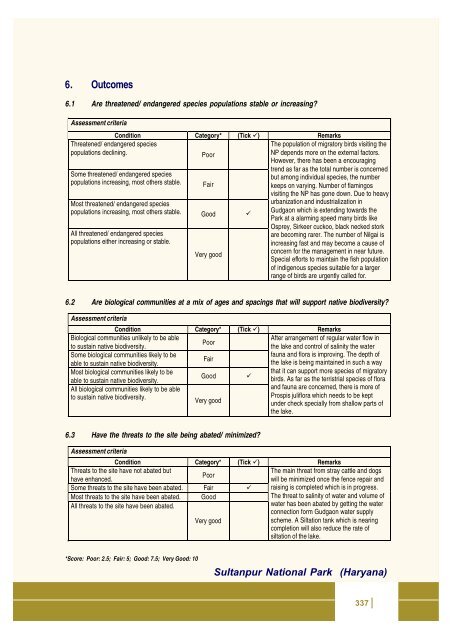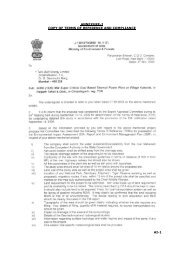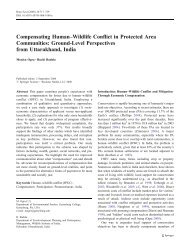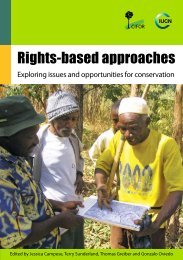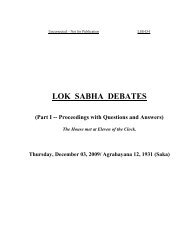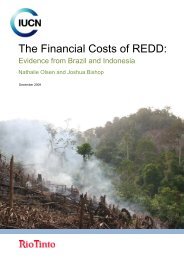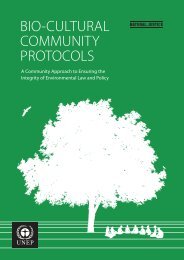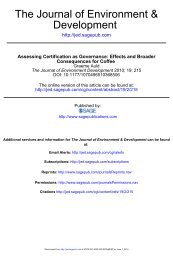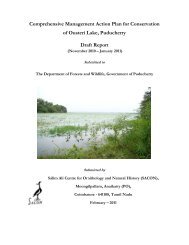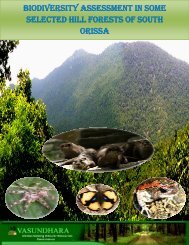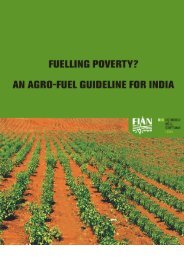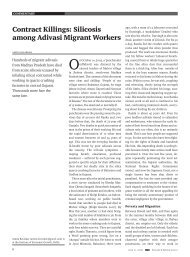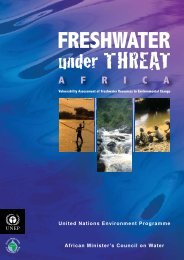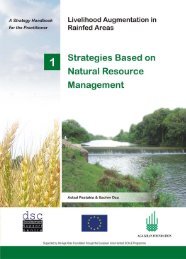- Page 2 and 3:
Management Effectiveness Evaluation
- Page 4 and 5:
Results at a Glance S. No. 1. 2. 3.
- Page 6 and 7:
Results at a Glance iii |
- Page 8 and 9:
Results at a Glance v |
- Page 10 and 11:
Results at a Glance vii |
- Page 12 and 13:
Results at a Glance ix |
- Page 14 and 15:
Results at a Glance xi |
- Page 16 and 17:
1. Barda Wildlife Sanctuary (Gujara
- Page 18 and 19:
2. Planning 2.1 Is the site properl
- Page 20 and 21:
2.7 Are reintroduction programmes s
- Page 22 and 23:
3.3 Are resources (human and financ
- Page 24 and 25:
4.4 Is there a responsive system fo
- Page 26 and 27:
6. Outcomes 6.1 Are threatened/ end
- Page 28 and 29:
2. Bhitarkanika Wildlife Sanctuary
- Page 30 and 31:
2. Planning 2.1 Is the site properl
- Page 32 and 33:
2.7 Are reintroduction programmes s
- Page 34 and 35:
3.3 Are resources (human and financ
- Page 36 and 37:
4.4 Is there a responsive system fo
- Page 38 and 39:
6. Outcomes 6.1 Are threatened/ end
- Page 40 and 41:
3. Dandeli Wildlife Sanctuary (Karn
- Page 42 and 43:
2. Planning 2.1 Is the site properl
- Page 44 and 45:
2.7 Are reintroduction programmes s
- Page 46 and 47:
3.3 Are resources (human and financ
- Page 48 and 49:
4.4 Is there a responsive system fo
- Page 50 and 51:
6. Outcomes 6.1 Are threatened/ end
- Page 52 and 53:
4. Govind Pashu Vihar (Uttarakhand)
- Page 54 and 55:
2. Planning 2.1 Is the site properl
- Page 56 and 57:
2.9 Has the site been effective in
- Page 58 and 59:
3.4 What level of resources is prov
- Page 60 and 61:
4.5 Does PA management addresses th
- Page 62 and 63:
6.2 Are biological communities at a
- Page 64 and 65:
5. Great Himalayan National Park (H
- Page 66 and 67:
2. Planning 2.1 Is the site properl
- Page 68 and 69:
2.6 Are habitat restoration program
- Page 70 and 71:
3.2 Are resources (vehicle, equipme
- Page 72 and 73:
4.2 Is PA staff performance managem
- Page 74 and 75:
5.3 Are management related trends s
- Page 76 and 77:
6.6 Are cultural heritage assets pr
- Page 78 and 79:
6. Gulf of Mannar National Park (Ta
- Page 80 and 81:
2. Planning 2.1 Is the site properl
- Page 82 and 83:
2.8 Does the site has an effective
- Page 84 and 85:
3.5 Does PA manager considers resou
- Page 86 and 87:
5. Output 5.1 Is adequate informati
- Page 88 and 89:
6.4 Are the expectations of visitor
- Page 90 and 91:
7. Jaldapara Wildlife Sanctuary (We
- Page 92 and 93:
2. Planning 2.1 Is the site properl
- Page 94 and 95:
2.8 Does the site has an effective
- Page 96 and 97:
3.5 Does PA manager considers resou
- Page 98 and 99:
5.2 Are visitor services (tourism a
- Page 100 and 101:
6.5 Are neighbours and adjacent com
- Page 102 and 103:
8. Keibul Lamjao National Park (Man
- Page 104 and 105:
2. Planning 2.1 Is the site properl
- Page 106 and 107:
2.8 Does the site has an effective
- Page 108 and 109:
3.5 Does PA manager considers resou
- Page 110 and 111:
5.2 Are visitor services (tourism a
- Page 112 and 113:
6.5 Are neighbours and adjacent com
- Page 114 and 115:
9. Keoladeo National Park (Rajastha
- Page 116 and 117:
2. Planning 2.1 Is the site properl
- Page 118 and 119:
2.8 Does the site has an effective
- Page 120 and 121:
3.5 Does PA manager considers resou
- Page 122 and 123:
5. Output 5.1 Is adequate informati
- Page 124 and 125:
6.3 Have the threats to the site be
- Page 126 and 127:
10. Khangchendzonga National Park (
- Page 128 and 129:
2. Planning 2.1 Is the site properl
- Page 130 and 131:
2.8 Does the site have an effective
- Page 132 and 133:
3.5 Does PA manager considers resou
- Page 134 and 135:
5. Output 5.1 Is adequate informati
- Page 136 and 137:
6.3 Have the threats to the site be
- Page 138 and 139:
11. Kishtwar National Park (J&K) Ki
- Page 140 and 141:
2. Planning 2.1 Is the site properl
- Page 142 and 143:
2.8 Does the site has an effective
- Page 144 and 145:
3.3 Are resources (human and financ
- Page 146 and 147:
4.4 Is there a responsive system fo
- Page 148 and 149:
6. Outcomes 6.1 Are threatened/ end
- Page 150 and 151:
MEE Score Card Framework Element Nu
- Page 152 and 153:
12. Kuno-Palpur Wildlife Sanctuary
- Page 154 and 155:
2.2 Does the site have a comprehens
- Page 156 and 157:
2.10 Is the site integrated into a
- Page 158 and 159:
4. Process 4.1 Does the site have t
- Page 160 and 161:
5.2 Are visitor services (tourism a
- Page 162 and 163:
6.5 Are neighbours and adjacent com
- Page 164 and 165:
13. Madhav National Park (MP) Madha
- Page 166 and 167:
2. Planning 2.1 Is the site properl
- Page 168 and 169:
2.7 Are reintroduction programmes s
- Page 170 and 171:
3.4 What level of resources is prov
- Page 172 and 173:
4.5 Does PA management addresses th
- Page 174 and 175:
6.2 Are biological communities at a
- Page 176 and 177:
14. Mahananda Wildlife Sanctuary (W
- Page 178 and 179:
2. Planning 2.1 Is the site properl
- Page 180 and 181:
2.7 Are reintroduction programmes s
- Page 182 and 183:
3.4 What level of resources is prov
- Page 184 and 185:
5. Output 5.1 Is adequate informati
- Page 186 and 187:
6.3 Have the threats to the site be
- Page 188 and 189:
15. Mahatma Gandhi National Park (A
- Page 190 and 191:
2. Planning 2.1 Is the site properl
- Page 192 and 193:
2.9 Has the site been effective in
- Page 194 and 195:
3.5 Does PA manager considers resou
- Page 196 and 197:
5.2 Are visitor services (tourism a
- Page 198 and 199:
6.5 Are neighbours and adjacent com
- Page 200 and 201:
16. Mahauadar Wildlife Sanctuary (J
- Page 202 and 203:
2. Planning 2.1 Is the site properl
- Page 204 and 205:
2.7 Are reintroduction programmers
- Page 206 and 207:
3.2 Are resources ( Vehicle, equipm
- Page 208 and 209:
4. Process 4.1 Does the site have t
- Page 210 and 211:
4.5 Does PA management addresses th
- Page 212 and 213:
5.4 Is there a systematic maintenan
- Page 214 and 215:
6.5 Are neighbours and adjacent com
- Page 216 and 217:
17. Mudumalai National Park (Tamil
- Page 218 and 219:
2. Planning 2.1 Is the site properl
- Page 220 and 221:
2.8 Does the site has an effective
- Page 222 and 223:
3.5 Does PA manager considers resou
- Page 224 and 225:
5.2 Are visitor services (tourism a
- Page 226 and 227:
6.5 Are neighbours and adjacent com
- Page 228 and 229:
18. National Chambal Wildlife Sanct
- Page 230 and 231:
2. Planning 2.1 Is the site properl
- Page 232 and 233:
2.9 Has the site been effective in
- Page 234 and 235:
3.3 Are resources (human and financ
- Page 236 and 237:
4.4 Is there a responsive system fo
- Page 238 and 239:
6. Outcomes 6.1 Are threatened/ end
- Page 240 and 241:
19. Navegaon National Park (Maharas
- Page 242 and 243:
2. Planning 2.1 Is the site properl
- Page 244 and 245:
2.7 Are reintroduction programmes s
- Page 246 and 247:
3.4 What level of resources is prov
- Page 248 and 249:
4.5 Does PA management addresses th
- Page 250 and 251:
6.2 Are biological communities at a
- Page 252 and 253:
20. Nongkhyllem National Park (Megh
- Page 254 and 255:
2. Planning 2.1 Is the site properl
- Page 256 and 257:
2.7 Are reintroduction programmes s
- Page 258 and 259:
3.3 Are resources (human and financ
- Page 260 and 261:
4.4 Is there a responsive system fo
- Page 262 and 263:
6. Outcomes 6.1 Are threatened/ end
- Page 264 and 265:
21. Papikonda Wildlife Sanctuary (A
- Page 266 and 267:
2. Planning 2.1 Is the site properl
- Page 268 and 269:
2.8 Does the site have an effective
- Page 270 and 271:
3.5 Does PA manager consider resour
- Page 272 and 273:
5.2 Are visitor services (tourism a
- Page 274 and 275:
6.5 Are neighbours and adjacent com
- Page 276 and 277:
22. Pobitora Sanctuary (Assam) Pobi
- Page 278 and 279:
2. Planning 2.1 Is the site properl
- Page 280 and 281:
2.7 Are reintroduction programmes s
- Page 282 and 283:
3.4 What level of resources is prov
- Page 284 and 285:
5. Output 5.1 Is adequate informati
- Page 286 and 287:
6.3 Have the threats to the site be
- Page 288 and 289:
23. Sanjay Gandhi National Park (Ma
- Page 290 and 291:
2. Planning 2.1 Is the site properl
- Page 292 and 293:
2.8 Does the site has an effective
- Page 294 and 295:
3.5 Does PA manager considers resou
- Page 296 and 297:
5.2 Are visitor services (tourism a
- Page 298 and 299:
6.5 Are neighbours and adjacent com
- Page 300 and 301:
24. Sepahijala Wildlife Sanctuary (
- Page 302 and 303: 1.4 Is there any human settlement w
- Page 304 and 305: 2.6 Is there any control mechanism
- Page 306 and 307: 2.13(2.9) Has the site been effecti
- Page 308 and 309: 3.3 Are resources (human and financ
- Page 310 and 311: 4.4 Is there a responsive system fo
- Page 312 and 313: 6. Outcomes 6.1 Are threatened/ end
- Page 314 and 315: MEE Score Card Framework Element Nu
- Page 316 and 317: 25. Sessa Orchid Wildlife Sanctuary
- Page 318 and 319: 2. Planning 2.1 Is the site properl
- Page 320 and 321: 2.9 Has the site been effective in
- Page 322 and 323: 3.5 Does PA manager considers resou
- Page 324 and 325: 5.2 Are visitor services (tourism a
- Page 326 and 327: 6.5 Are neighbours and adjacent com
- Page 328 and 329: 26. Sohelwa Wildlife Sanctuary (Utt
- Page 330 and 331: 2. Planning 2.1 Is the site properl
- Page 332 and 333: 2.6 Are habitat restoration program
- Page 334 and 335: 3.2 Are resources (vehicle, equipme
- Page 336 and 337: 4.2 Is PA staff performance managem
- Page 338 and 339: 5.3 Are management related trends s
- Page 340 and 341: 6.6 Are cultural heritage assets pr
- Page 342 and 343: 27. Sultanpur National Park (Haryan
- Page 344 and 345: 1.3 Is the site free from human and
- Page 346 and 347: 2.8 Does the site has an effective
- Page 348 and 349: 3.4 What level of resources is prov
- Page 350 and 351: 5. Output 5.1 Is adequate informati
- Page 354 and 355: MEE Score Card Framework Element Nu
- Page 356 and 357: 28. Sunebeda Wildlife Sanctuary (Or
- Page 358 and 359: 2. Planning 2.1 Is the site properl
- Page 360 and 361: 2.8 Does the site has an effective
- Page 362 and 363: 3.5 Does PA manager considers resou
- Page 364 and 365: 5.2 Are visitor services (tourism a
- Page 366 and 367: 6.5 Are neighbours and adjacent com
- Page 368 and 369: 29. Udanti Wildlife Sanctuary (Chha
- Page 370 and 371: 2. Planning 2.1 Is the site properl
- Page 372 and 373: 2.9 Has the site been effective in
- Page 374 and 375: 3.5 Does PA manager considers resou
- Page 376 and 377: 5.2 Are visitor services (tourism a
- Page 378 and 379: 6.5 Are neighbours and adjacent com
- Page 380 and 381: 30. Wayanad Wildlife Sanctuary (Ker
- Page 382 and 383: 2. Planning 2.1 Is the site properl
- Page 384 and 385: 2.8 Does the site has an effective
- Page 386 and 387: 3.5 Does PA manager considers resou
- Page 388 and 389: 5.2 Are visitor services (tourism a
- Page 390 and 391: 6.5 Are neighbours and adjacent com
- Page 392 and 393: Annexure-I SITE Assessment Criteria
- Page 394 and 395: 2.7 Are reintroduction programmes s
- Page 396 and 397: 4. Process SITE 4.1 Does the site h
- Page 398 and 399: SITE 5.4 Is there a systematic main


